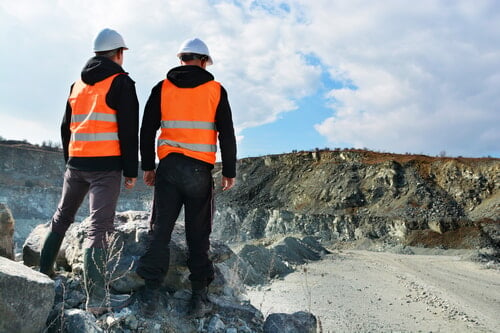Personal Protective Equipment

Quarrying
Over the millennium, people mined rock and other minerals. In the stone age, people looked for flint to create hammers, cutting tools, scrapers, and hand axes. Egyptians sawed and drilled rock. The Romans also cut stone and used a technique called plugging and feathering. The United States has thousands of quarries – usually a dip pit, where workers excavate rock and stone. Common products of quarries include granite, crushed stone, marble, gravel and sand. The pits are close to the surface.
Types of Quarrying
The two types of quarrying are based on the type of product mined. The dimension stone industry mines marble, granite, slate and limestone. The stone is cut with powerful equipment and is used for floors, walls, monuments and headstones.
The aggregate industry mines stone, sand and gravel for building materials and roads. The primary way to get the aggregate out of the ground is through blasting and explosives. Portland cement, used in many industries, including home construction and road construction, requires sand, gravel and limestone.
Quarrying Occupations and Personal Protective Equipment
Quarrying workers work in several different occupations, including:
- Chemical processing machine operators operate machines that control chemical changes and reactions during the processing of the quarried material. They should have chemical-resistant gloves, waterproof clothing, face shields, goggles, and hard hats to protect themselves from chemicals and aggregate falling onto their heads.
- Construction laborers and extraction occupation workers perform physical labor at construction sites, including blasting, drilling, and running derricks and mining machines. They use hand tools to repair drilling equipment, and they transport materials. These workers should have impact gloves,hi-vis clothing, and safety glasses or goggles.
- Crushing, grinding and polishing machine setters, tenders, and operators run the machines that crush and polish stone. They often work with chemicals and should have waterproof gloves and clothing, goggles, and face shields. They may also use picks and collecting materials and should use impact gloves for those types of jobs.
- Earth drillers run different types of drills to make using explosives easier. Workers work with mixing chemicals, using picks and collecting materials.
- Explosive workers place explosives in rocks and detonate the explosives to remove, loosen, or displace rock, earth and other materials.
- Furnace, oven, kiln, drier and kettle operators work around heat. In addition to safety glasses or goggles, they should wear FR clothing.
- Mobile heavy equipment mechanics repair heavy equipment. They need gloves that have a good grip, so greasy parts and tools don’t slip out of their hands.
- Welding, brazing and soldering workers weld or solder repair equipment with welders and other tools that produce heat. They should always wear fire-resistant clothing.
- Extraction workers clean areas, supply equipment, and repair drilling equipment. They may drill, blast, and operate mining machines and derricks. They should have impact gloves, abrasion-resistant gloves, hi-vis clothing, and face and eye protection.
- Industrial machinery mechanics install, repair and adjust industrial machinery. They might cut and weld metal to repair broken parts. These workers should have puncture-resistant gloves and face and eye protection.
- Quarry rock splitters use jackhammers and wedges to cut blocks into rough dimensions. They move pieces of stone, cut slabs, and insert wedges into holes. Quarry rock splitters should have face and eye protection, impact gloves and puncture-resistant gloves.
- Inspectors, sorters, testers, weighers and samplers inspect parts fabricated and assembled on site. They may often work with sharp metal and should have puncture-resistant gloves and face and eye protection.
- Machine operators, including continuous mining machine operators, dredge operators, excavator operators and loading machine operators, operate large equipment. They are susceptible to falling materials and break up and mine various materials with the machines. Continuous mining machine operators also rip metal, coal and various ores. Face and eye protection, hi-vis clothing, and impact gloves or abrasion-resistant gloves should be part of the personal protective equipment they wear.
Additional occupations include:
- Loading and excavating machine and dragline operators.
- Heavy vehicle and mobile equipment service techs.
- Laborers and material movers who move material by hand.
- Packaging and filling machine operators and tenders.
- Filtering, separating, precipitating, clarifying and still machine operators.
Contact Abolox
The personal protective equipment Abolox carries is of top quality and meets industry standards. Visit Abolox to order the PPE you need. We sell PPE in individual pieces or in bulk for those who purchase it for their workers. If you don’t see what you need, contact us, and we will source it for you.